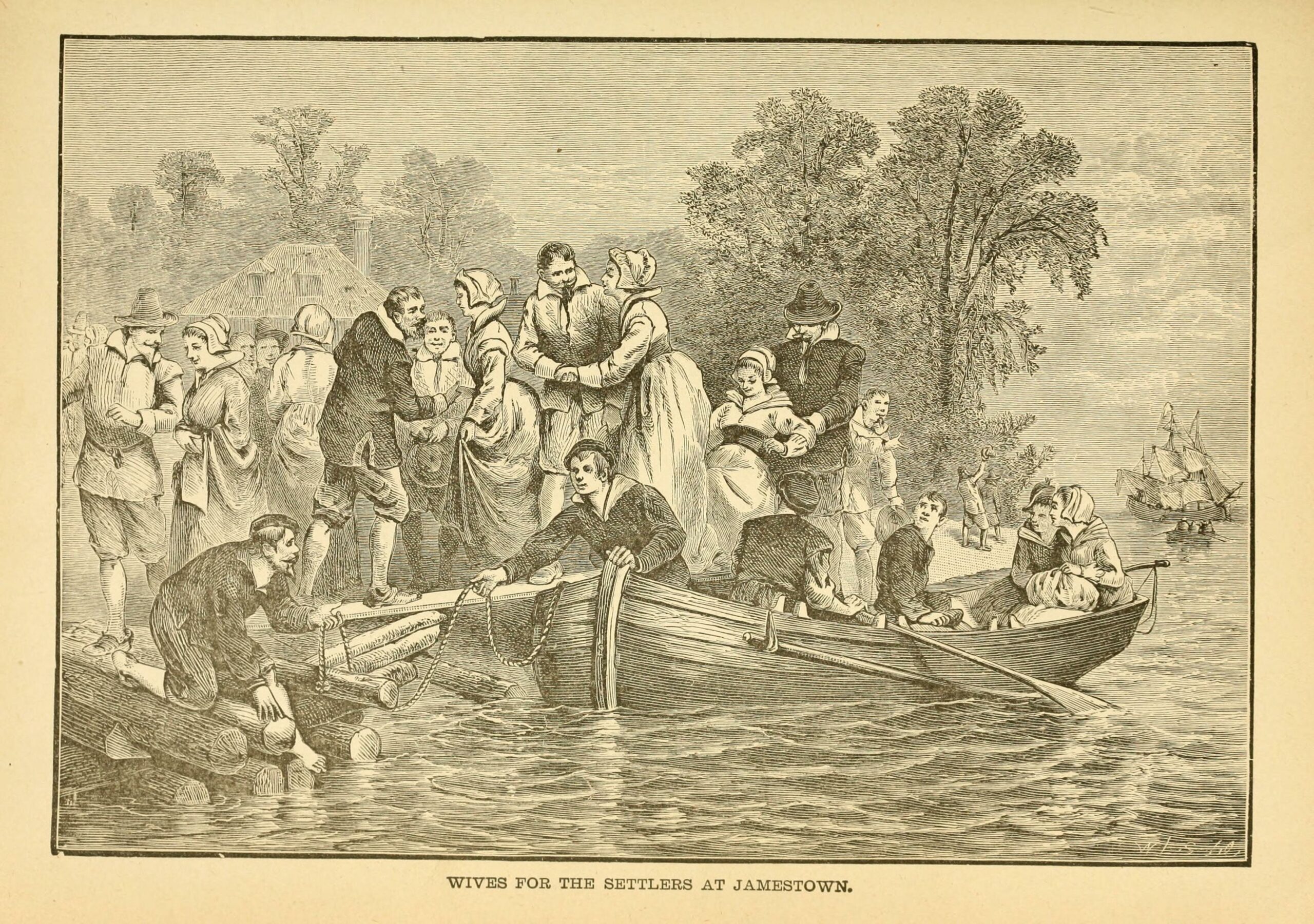“Wives for the Settlers of Jamestown” in United States; a history: the most complete and most popular history of the United States of America from the aboriginal times to the present day…
John Clark Ridpath, “Wives for the Settlers of Jamestown” in United States; a history: the most complete and most popular history of the United States of America from the aboriginal times to the present day…, 1893. Library of Congress.
Background
Established in 1607, Jamestown, Virginia, was the first permanent English colony in the Americas. Jamestown’s first settlers were exclusively men and boys. In its earliest days, the colony suffered from a shortage of women. Almost all the settlement’s residents were men who came to make their fortunes. After achieving their goal, the men would leave the colony to find wives and start families. Every time a successful colonist left, he took his hard-earned knowledge, skills, and money with him.
The leaders of the Virginia Company came up with a plan to keep successful men from leaving. They placed advertisements in newspapers back in England, offering any woman who came to Jamestown to marry a colonist free passage across the Atlantic, a dowry of clothing and home goods, and a plot of land. Furthermore, coverture laws were more relaxed in the Virginia colony, giving women more property and inheritance rights than in England.
The first group of ninety women arrived in 1620. When the women arrived in Jamestown, they were sheltered and fed by the company until they chose a husband. The women had total control over the decision of who to marry. Once a woman married, her new husband was required to pay the Virginia Company back for the cost of bringing the woman to the colony. The payment was originally 120 pounds of tobacco leaves. This led to the nickname “tobacco brides” for women who arrived as part of this program.
The following year, a second group of fifty-six women arrived in the Virginia colony. Almost all the “tobacco brides” married colonists. The program appears to have ended after two groups of women came to Virginia, maybe because there was no longer a strong need for brides in the colony. These women contributed significantly to the establishment of Virginia as a permanent settlement.
About the Artifacts
The drawing depicts women arriving in Jamestown and receiving a warm welcome from the male settlers of the colony. It was created over two centuries after the tobacco brides first arrived in Virginia and contains some historical inaccuracies. For example, it shows the men and women pairing up immediately, when it took weeks to months for women to decide who to marry.
Vocabulary
- coverture: A common law practice where women fell under the legal and economic oversight of their husbands upon marriage.
- dowry: Property a woman brought with her to a marriage.
- Virginia Company: The English trading company established by the king to settle in North America.
Discussion Questions
- What is happening in this image? Why is this event significant to the history of the United States?
- Why did women sign up to become tobacco brides? What challenges might they have faced in as a result of their decision?
- The image was created several centuries after the tobacco brides arrived in Jamestown. Why do you think the artist chose to make it? How accurate do you think this depiction of the event is? How does the artist feel about this event? Do you think this is an accurate portrayal of what it was like to be a tobacco bride?
- What do the tobacco brides reveal about the role of women in the development of the Jamestown settlement?
Suggested Activities
- APUSH Connection: 2.3 The Regions of British Colonies
- Include this image in a lesson about the settlement of Jamestown, Virginia. The image helps students understand how colonies could be deliberately shaped through government and business interventions, and that women were vital to the long-term success of a settlement.
- Teach this resource alongside Marrying into the New World and The Casket Girls. What did both groups of women have in common? What does the existence of both the filles du roi and tobacco brides say about the role of women in colonial settlements?
- Consider what these women’s lives might have been like after they settled in Virginia by combining this resource with any of the following:
- Combine this resource with any of the following to consider how women contributed to the growth and development of the colonies:
Themes
DOMESTICITY AND FAMILY; IMMIGRATION, MIGRATION, AND SETTLEMENT







